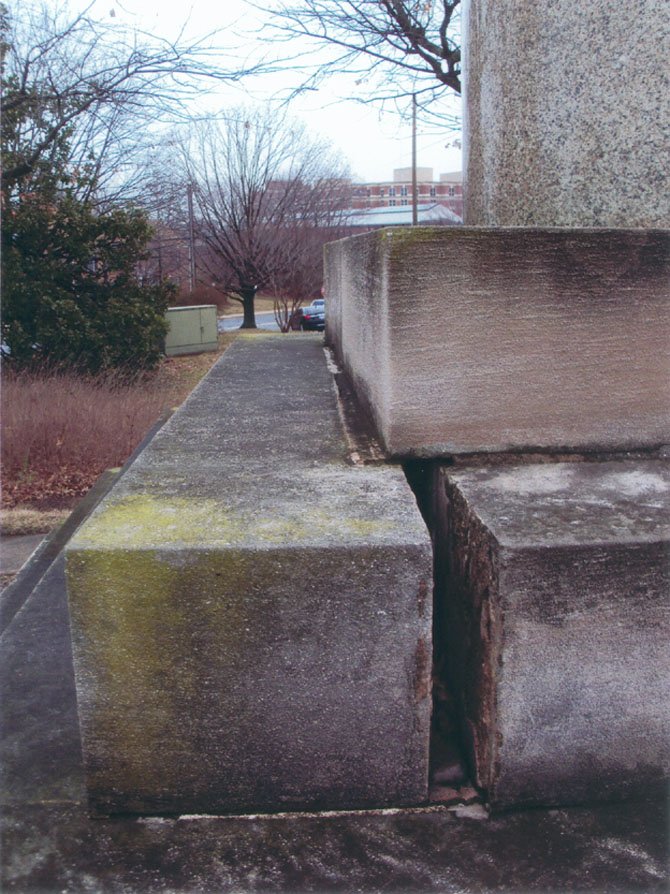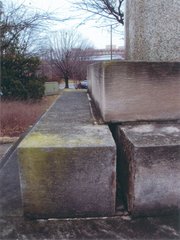The monument in front of Alexandria's railroad station is a pledge that residents who die in wartime service never will be forgotten. How, then, could the monument itself be so forgotten?
On Monday, Nov. 11, 1940, a crowd of 3,000 gathered for the dedication. Speakers, whose words were not recorded, undoubtedly said the sacrifices of the dead would be remembered forever. But time has affected the stones representing those promises. Decay has set in. Joints are opening. Mortar and caulking have fallen aside, preparing the way for further damage. Those who participated in the long-ago ceremonies would be taken aback at what is visible today.
Hiatory - Who Is Responsible for the Memorial?
Newspaper articles from 1940 declare that the plot on which the war memorial stands was provided by the then-owner of the station: Richmond, Fredericksburg and Potomac Railroad. The terms used were "donated" and "given." Nearly 25 years later, another article referred to a "lease" for "a period of 99 years." The recipient of property rights in either case was Veterans of Foreign Wars, Post No. 609. When asked, current Post Commander William Jones advised that most of the unit's files had been lost over the years; he had no paper saying Post No. 609 was owner or lessee of the small parcel of land.
A search of land records in Alexandria Courthouse uncovered no recording of a document conveying fee title or lengthy lease of the plot.
City of Alexandria's "GIS" database indicates the city owns the site on which the memorial stands. Whether it also asserts ownership of the memorial remains an open question.
Those deciding the company's historical importance deserved to be preserved founded the Richmond, Fredericksburg & Potomac Railroad Historical Society in 2005. The society collects corporate records and memorabilia of the railroad. Recently, a search request was submitted for any mention of the memorial and Post 609 in its collections. As this article went to press, nothing yet had been uncovered.
The best hope of determining ownership and responsibility for the memorial lies with the professional researchers currently under contract with the city to evaluate the condition of various public works of art and monuments. The Memorial is on the list.
Fannie F. Meeks of Alexandria, an officer of Gold Star Mothers, unveiled the memorial. Doubtless she was recalling memories of her son, David L., killed in the last few days of World War I. Prayers offered by Rt. Rev. Msgr. T. A. Rankin of St. Mary's Church, Pastor Norman Roberts of Methodist Protestant Church and Rabbi Benjamin N. Goldberg of Agudas Achim Congregation sounded over the crowd and blended with the civic wordings of Mayor William T. Wilkins. With a final glance, the throng departed filled with good intentions of remembering the dead.
The plaque recounting those who mounted the memorial name three parties: Mrs. Florence Angelo Cannaday of Richmond; Russell Mitchell Post No. 609, Veterans of Foreign Wars, and Citizens of Alexandria.
Cannaday was the primary donor, to the tune of $4,000; today that sum would amount to about $75,000. Her stated purpose was to honor the memory of her deceased husband, Alfred Frederick Cannaday. A long-time executive of the Richmond, Fredericksburg & Potomac Railroad, he was well known in Alexandria. Building the memorial on RF&P property and official presence of the railroad's president at the dedication, therefore, prompt no surprise.
Post No. 609's involvement role was straight forward, but inherited. Years earlier, the idea of a memorial originated in a local American Legion Post, but no action resulted. Interest percolated in Post No. 609's Ladies Auxiliary until concrete planning was undertaken by the Post itself in the late 1930s. Post No. 609 was principal organizer and, with its social club, a $1,000 donor.
As to the Citizens of Alexandria, a public subscription failed. In the end, the City Council appropriated $500.
Some aspects of the war memorial's beginnings are lost in time, leaving only intriguing questions. How is it that a discarded piece of the George Washington National Masonic Memorial atop Shuter's Hill became the vertical shaft of the War Memorial? Was there a behind-the-scenes role played by David E. Bayliss, Jr., the prominent local architect who designed the war memorial but who also was active in Masonic affairs in the City of Alexandria? Even generous cooperation by Mark A. Tabbert, Librarian/Director of Collections at the Masonic Memorial could not answer those questions. Above all, ownership of the war memorial and the land on which it sits is far from clear.
The city's Office of the Arts was contacted for information and led to an interview with its director, Diane Ruggiero. "You could not have arrived at a better time," she said. "We have just awarded a contract for a firm to conduct 'condition assessments' of about two dozen items of public art and public memorials. The war memorial is on the list." She added that the report is expected during the summer. It will include the history of each item, technical details of its present condition and recommendations for repair and restoration. Her office will be prioritizing work and developing a proposed budget. Ruggiero emphasized that the report and all that follows will be available to the public and citizen comments will be invited.
Nov. 11, 2015, will be the 75th anniversary of the memorial. Post No. 609 is considering a re-dedication ceremony. The city's Office of the Arts is studying the physical condition of the memorial. Restoration seems to be within reach. There is no better time than this year's Memorial Day to begin renewing the promise of not forgetting.


